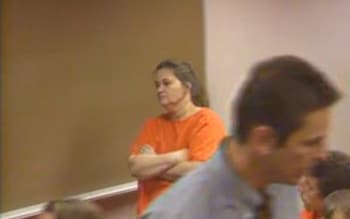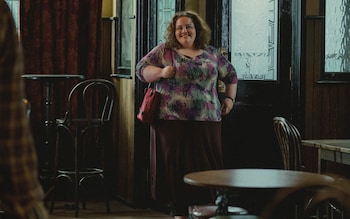 David Letterman in 1989 Photo: WireImage
David Letterman in 1989 Photo: WireImage
In May 1988, a woman was questioned on her way to New York through the Lincoln Tunnel. . A woman driving a Porsche with a three-year-old boy in the car did not pay the $3 toll. She told the toll collector that she was the wife of late-night talk show host David Letterman. “I’m Mrs. David Letterman, and this is David Jr.,” she said. «Don't you think David Letterman would be up to the task?»
The car was indeed Letterman's $80,000 Porsche, but the woman was not Letterman's wife. It was Margaret Mary Ray, stalker and schizophrenic. The boy turned out to be her son Alex. Ray stole Letterman's Porsche from his driveway, the first recorded incident in a high-profile and strangely brazen stalking campaign. For several years, Ray would break into Letterman's house, where she would surprise him at night, leave strange gifts, and even do housework.
Ray became national news and made headlines—in fact, a national joke when Letterman chronicled his exploits on his show Late Night with David Letterman. He later noted that he never mentioned her name on air and never pressed charges. “I didn’t like the humanity,” Letterman said.
Ten years after Letterman's Porsche was stolen, Margaret Mary Ray, also known as Peggy, committed suicide. She knelt in front of a 105-car coal train.
Netflix's dark comedy drama Fawn has echoes of Margaret Mary Ray and her desperately sad mental illness. Created and written by comedian Richard Gadd, Baby Fawn is based on his one-man show of the same name, a fictional account of his own ordeal at the hands of a stalker with striking similarities in many ways to Margaret Mary Ray.

The very tense and uncomfortable film “Fawn” is not a stalker-thriller in the spirit of “Fatal Attraction,” but a portrait of a stalker , and pursued. The portrayal of stalker Martha (Jessica Gunning) is painfully sympathetic. Like Margaret Mary Ray, she is a very sick woman.
There were other cases of celebrity stalking in the pre-Internet era, when the interaction had to be real and physical — before stalkers could send more than 41,000 emails, as happened with Richard Gadd. Most famously, John Hinckley Jr. was obsessed with Jodie Foster. He sent her letters and left messages, and then tried to kill US President Ronald Reagan to get Foster's attention.
Olivia Newton-John became the target of two stalkers. The first, Michael Owen Perry, put her on a list of people he wanted to kill and killed five members of his family, and the second snuck into Newton-John's bed while she was on vacation. In 1995, Robert Dewey Hoskins tried to break into Madonna's home and threatened to marry or kill her. He was shot twice and sentenced to ten years in prison. However, stalkers were not always taken seriously, especially, in the case of Margaret Mary Ray, female stalkers.
Ray was born in 1952 and grew up in Grayslake, Illinois. A childhood neighbor later described her as «the most wonderful, beautiful American girl.» However, her family suffered from schizophrenia. Her father, a factory worker named George, was believed to have suffered from the disease. She was one of four siblings, and had two brothers who were also schizophrenic and committed suicide. One brother crashed into a tree at the age of 22. Another filled his garage with carbon monoxide when he was just 21 years old. «My family paid our dues, and I'm not sure what we did wrong,» her mother, Loretta Duvall, later said. .
 Margaret Mary Ray in court
Margaret Mary Ray in court
Ray married in 1973 and had four children. In 1983, she divorced and gave custody of the children to their father as a result of her deteriorating mental state. According to his obituary in The New York Times, Ray hitchhiked across the United States and lived in shacks without running water. She had a fifth child with an unknown father — Alex, the boy who was with her in Letterman's Porsche. Ray's mother eventually took custody of Alex.
Ray settled in Hotchkiss, where she worked part-time and made friends. After her death, friends and neighbors unanimously spoke well of her — that there was more to her than the schizophrenia that eventually consumed her. “She filled my life with riches,” said one friend. «Cute, incredibly cute.» But she also suddenly disappeared and suffered from fits of anger.
As it was reported at the time, Ray first entered David Letterman's house in May 1988 — around the time she stole his Porsche. Letterman was out of town and she twice tried to move into his New Canaan, Connecticut home with her son. By the following year, she had achieved her own celebrity status. Rae was interviewed on the television show A Current Affair in which she explained that she fell in love with Letterman after seeing him in a documentary. «I can tell you it was love at first sight,» she said.
Ray also admitted, “I don’t think there’s another woman in the world who could love David Letterman as much as I do.”
Dr. Louis B. Schlesinger, professor of psychology at John Jay College of Criminal Justice, discussed Ray's case in an ITV documentary. Schlesinger described a rare delusional condition called erotomania, a subtype of schizophrenia that causes the sufferer to believe that the object of their obsession—usually someone of higher social status—is in love with them.
 Margaret Mary Ray broke into David Letterman's former home in Connecticut several times. Photo: Getty
Margaret Mary Ray broke into David Letterman's former home in Connecticut several times. Photo: Getty
On other occasions, she was found sleeping near his tennis courts. She also broke into his home and left gifts — an empty bottle of Jack Daniel's and cookies — in his hallway. Another time, she left him a meditation book and a letter in his driveway. In fact, she wrote to him many times. Letterman could tell whether she was taking medication or not by the way she wrote. «When she was on them, it was like a message from your aunt,» he later said. “When she was without them, it was like a message from your aunt in Neptune.”
During one of the break-ins, for which she was sentenced to nine months in prison, Rae admitted that she was busy at the Letterman mansion by “writing, watching TV, cleaning, washing windows and mopping floors.” She added: “I enjoy working around the house.”
On another occasion, Rae explained her infiltration of police as a “surprise visit” and once told a suspicious taxi driver: “He’s waiting for me. I need to submit documents. At some point, Ray convinced the salesmen working at Letterman's house that she was his wife, and they gave her a ride into town.
The New York Times reported that Letterman felt threatened only once—while he was lying in bed. One night with his girlfriend, he looked up and saw Ray standing in the hallway. According to Letterman, she immediately fled. He reportedly found her sleeping in the guest bedroom one day. In total, Ray was arrested eight times for trespassing on Letterman's territory.

A 1990 column in an Ohio newspaper summed up the media reaction in which a columnist published a conversation she allegedly had with a friend about Ray. “Don’t you think Letterman should give in and pay attention to her?” said the friend. “After all, he is not getting any younger and is not married. He's definitely no Tom Cruise or Mel Gibson. Maybe it’s better for him to take advantage of the situation?” The reviewer was unsympathetic. «You've got to be kidding me…she must be crazy.»
Letterman himself poked fun at the situation on his TV show. When he broadcast Late Night with David Letterman from NBC to CBS in 1993, Letterman listed “things I need to do before I leave NBC,” including “sending change of address forms to that woman who breaks into my house.” «.
To celebrate the move, the Los Angeles Daily News held a mock multiple-choice quiz about his show's years on NBC. The story of the persecution was so widely known that when asked «who was Dave's first guest on his first show?» Answers included Bill Murray, Johnny Carson and Margaret Ray.
Letterman also took a more serious stance on the issue. He told The Advocate: “The fact is she is crazy. And you don't want to do anything that could make the situation worse than it already is. It's been five years, I've tried a lot of things, but none of them worked.»
After her death, forensic psychologist Reed Meloy commented on how Letterman's jokes may have intensified her obsession. «David Letterman unwittingly contributed to her delusion by mentioning her on his late-night show,» Meloy explained. “He makes her delusional fantasy come true in front of millions of television viewers.” According to Ray's mother, these illusions «made her feel important.» “She loved it.”
 David Letterman interviews the Duchess of York in 1996 Photo: AP
David Letterman interviews the Duchess of York in 1996 Photo: AP
Ray's daughter, Anna-Lisa Johansson, said that «the attention given to her and the actions of the authorities made her situation even worse.»
According to reports at the time, Anna-Lisa was forced to take out a restraining order against her mother — and she told her university to call the police if they ever saw Ray. “I always loved my mother,” Anna-Lisa said, “but I hated the woman who broke into David Letterman’s house.”
Ray spent several stints in prison and mental institutions for trespassing—a total of reportedly 24 months. After serving seven months of her original nine-month sentence, she was released on Friday and returned to Letterman's house by Sunday.
While incarcerated, Ray's mental state improved with the help of medication. But her health will worsen as soon as she is released and she stops taking her medication.
After five years of pursuing Letterman, Ray's attention turned to astronaut Franklin Story Musgrave. Ray wrote him letters and sent him packages. She also broke into his house and turned on all the taps. In another incident, she posed as a reporter and interviewed Musgrave at the Johnson Space Center in Houston. Musgrave suspected something was wrong when she didn't take any notes. When she wrote to Musgrave as a reporter, he recognized her handwriting. Ray was sentenced to prison in Florida for stalking Musgrave. When she was released, even the judge criticized the lack of legal support that would have allowed Ray to get the medical help she needed.
A month before her death, Ray appeared on the television magazine Extra, where she opened up about her mental health problems and said, that she thought David Letterman understood her.
Margaret Mary Ray committed suicide in October. 5 1998 — in a remote location near Hotchkiss, Colorado. She was 46 years old. She wrote her mother one last letter, in which she wrote: “I have left” and “I have chosen a painless and immediate way to end my life in the valley that I loved.”
At the scene of her death, she placed her purse on the ground with a note containing the phone number of a friend who could contact her family. David Letterman responded to the news through his representative. «It's a sad end to a complicated life,» he said.
 Jessica Gunning as Martha in Fawn. Ed Miller/Netflix
Jessica Gunning as Martha in Fawn. Ed Miller/Netflix
Oddly enough, her celebrity continued. At the end of 1998, American newspapers included her among the notable and high-profile deaths of that year, along with Tammy Wynette, Linda McCartney, Dr. Spock and Lloyd Bridges. The strange behavior — reliable tabloid fodder — overshadowed the tragedy of her mental illness. “Margaret Mary Ray,” the ad read. «David Letterman was stalked.»
Baby Reindeer treats its subject with the sympathy that Margaret Mary Ray deserved when she was making headlines. In an interview with The Telegraph in 2019, Richard Gadd said that over several years his stalker sent him 41,071 emails, 350 hours of voicemail, 744 tweets, 46 Facebook messages, 106 pages of letters, sleeping pills, a woolly hat, a pair of boxers. shorts and a cuddly reindeer toy.
She also showed up at his work, at his comedy gigs, and spread the rumor that his father was a pedophile. According to him, the stalker rode a “freight train” through all the important aspects of his life. The police didn't take it seriously at first. “I was told off for being harassed by the police,” he told The Guardian. He added: “I've been through two police investigations in my life and they were both hilarious and terrifying. Honestly, my advice to anyone who's ever thought about filing charges is this: It's a bloody nightmare process and it takes years.»
Gadd, like David Letterman, never named his stalker. . . Her portrayal in “Fawn” is “an emotional truth, not a factual description of a person,” Gadd told GQ. Gadd even scrutinizes his own behavior and remains compassionate. As he said in 2019: «I'm not the only victim, she's probably a bigger victim than me.»
























































Свежие комментарии